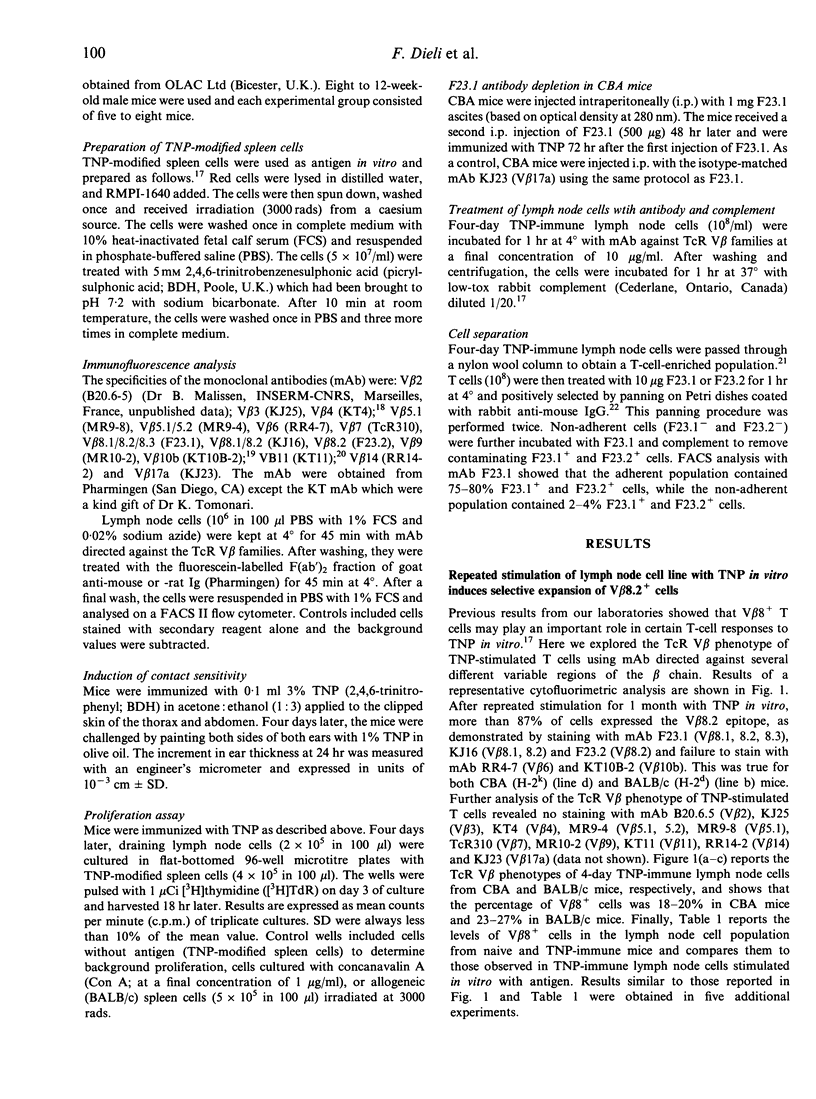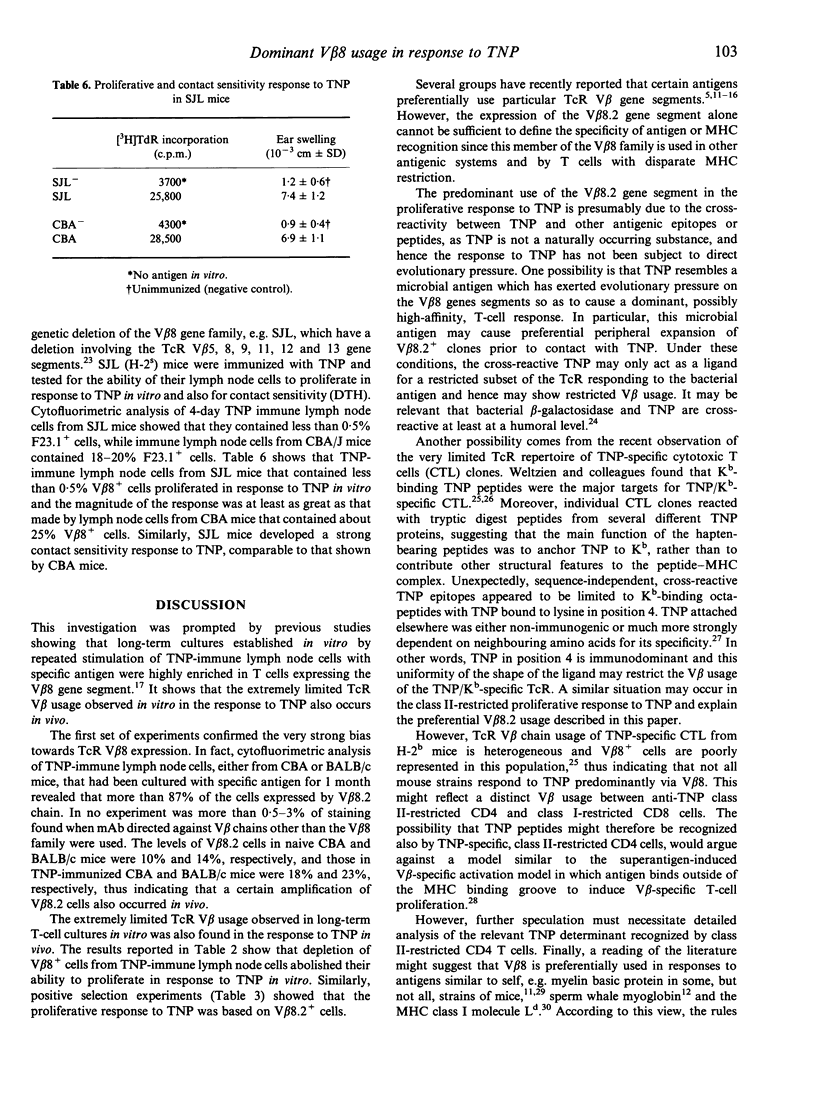Abstract
This paper investigates the V beta usage of lymph node cells from mice immunized with TNP and of cell lines made from them. In cell lines stimulated weekly with TNP in vitro for 1 month, about 87% of the cells were V beta 8+ and further analysis showed that these cells were actually V beta 8.2+. This was also true for the cells that proliferated in lymph nodes in response to TNP 4 days after primary immunization, i.e. proliferation occurred mainly in the V beta 8+, and in particular in the V beta 8.2+, population while much less proliferation occurred when the V beta 8- or V beta 8.2- T-cell populations are used. This was not due to non-specific damage during separation, as the response to concanavalin A and alloantigen was intact. In a separate series of experiments, mice were acutely depleted of V beta 8+ T cells by treatment with F23.1 or a control monoclonal antibody (mAb) in vivo given before immunization. Treatment with the relevant mAb virtually abolished the response to TNP. In contrast, SJL mice, which lack the gene segment coding for the V beta 8 family and several other V beta chains, made a normal proliferative and delayed-type hypersensitivity (DTH) response to TNP. This poses the problem, which may be important in the study of the T-cell repertoire, of why acute removal of V beta 8+ T cells, which are dominantly used in the response to TNP, does not allow T cells using other chains to substitute in the response, while the absence of this population over a long period of time, because of a deletion in the genome, allows the use of T cells bearing other V beta chains.
Full text
PDF






Selected References
These references are in PubMed. This may not be the complete list of references from this article.
- Acha-Orbea H., Mitchell D. J., Timmermann L., Wraith D. C., Tausch G. S., Waldor M. K., Zamvil S. S., McDevitt H. O., Steinman L. Limited heterogeneity of T cell receptors from lymphocytes mediating autoimmune encephalomyelitis allows specific immune intervention. Cell. 1988 Jul 15;54(2):263–273. doi: 10.1016/0092-8674(88)90558-2. [DOI] [PubMed] [Google Scholar]
- Asherson G. L., Dieli F. Immune deviation in the mouse: transfer of selective depression of the contact sensitivity and interleukin-2 response with retention of interferon-gamma production requires CD8+ T cells. Immunology. 1992 Jul;76(3):427–432. [PMC free article] [PubMed] [Google Scholar]
- Behlke M. A., Chou H. S., Huppi K., Loh D. Y. Murine T-cell receptor mutants with deletions of beta-chain variable region genes. Proc Natl Acad Sci U S A. 1986 Feb;83(3):767–771. doi: 10.1073/pnas.83.3.767. [DOI] [PMC free article] [PubMed] [Google Scholar]
- Danska J. S., Livingstone A. M., Paragas V., Ishihara T., Fathman C. G. The presumptive CDR3 regions of both T cell receptor alpha and beta chains determine T cell specificity for myoglobin peptides. J Exp Med. 1990 Jul 1;172(1):27–33. doi: 10.1084/jem.172.1.27. [DOI] [PMC free article] [PubMed] [Google Scholar]
- Falcioni F., Dembic Z., Muller S., Lehmann P. V., Nagy Z. A. Flexibility of the T cell repertoire. Self tolerance causes a shift of T cell receptor gene usage in response to insulin. J Exp Med. 1990 May 1;171(5):1665–1681. doi: 10.1084/jem.171.5.1665. [DOI] [PMC free article] [PubMed] [Google Scholar]
- Fink P. J., Matis L. A., McElligott D. L., Bookman M., Hedrick S. M. Correlations between T-cell specificity and the structure of the antigen receptor. Nature. 1986 May 15;321(6067):219–226. doi: 10.1038/321219a0. [DOI] [PubMed] [Google Scholar]
- Frangoulis B., Pla M., Rammensee H. G. Alternative T cell receptor gene usage induced by self tolerance. Eur J Immunol. 1989 Mar;19(3):553–555. doi: 10.1002/eji.1830190322. [DOI] [PubMed] [Google Scholar]
- Golding B., Inghirami G., Peters E., Hoffman T., Balow J. E., Tsokos G. C. In vitro generated human monoclonal trinitrophenyl-specific B cell lines. Evidence that human and murine anti-trinitrophenyl monoclonal antibodies cross-react with Escherichia coli beta-galactosidase. J Immunol. 1987 Dec 15;139(12):4061–4066. [PubMed] [Google Scholar]
- Hedrick S. M., Engel I., McElligott D. L., Fink P. J., Hsu M. L., Hansburg D., Matis L. A. Selection of amino acid sequences in the beta chain of the T cell antigen receptor. Science. 1988 Mar 25;239(4847):1541–1544. doi: 10.1126/science.2832942. [DOI] [PubMed] [Google Scholar]
- Hochgeschwender U., Simon H. G., Weltzien H. U., Bartels F., Becker A., Epplen J. T. Dominance of one T-cell receptor in the H-2Kb/TNP response. Nature. 1987 Mar 19;326(6110):307–309. doi: 10.1038/326307a0. [DOI] [PubMed] [Google Scholar]
- Jardetzky T. S., Lane W. S., Robinson R. A., Madden D. R., Wiley D. C. Identification of self peptides bound to purified HLA-B27. Nature. 1991 Sep 26;353(6342):326–329. doi: 10.1038/353326a0. [DOI] [PubMed] [Google Scholar]
- Jorgensen J. L., Esser U., Fazekas de St Groth B., Reay P. A., Davis M. M. Mapping T-cell receptor-peptide contacts by variant peptide immunization of single-chain transgenics. Nature. 1992 Jan 16;355(6357):224–230. doi: 10.1038/355224a0. [DOI] [PubMed] [Google Scholar]
- Julius M. H., Simpson E., Herzenberg L. A. A rapid method for the isolation of functional thymus-derived murine lymphocytes. Eur J Immunol. 1973 Oct;3(10):645–649. doi: 10.1002/eji.1830031011. [DOI] [PubMed] [Google Scholar]
- Kempkes B., Palmer E., Martin S., von Bonin A., Eichmann K., Ortmann B., Weltzien H. U. Predominant T cell receptor gene elements in TNP-specific cytotoxic T cells. J Immunol. 1991 Oct 15;147(8):2467–2473. [PubMed] [Google Scholar]
- Lai M. Z., Huang S. Y., Briner T. J., Guillet J. G., Smith J. A., Gefter M. L. T cell receptor gene usage in the response to lambda repressor cI protein. An apparent bias in the usage of a V alpha gene element. J Exp Med. 1988 Sep 1;168(3):1081–1097. doi: 10.1084/jem.168.3.1081. [DOI] [PMC free article] [PubMed] [Google Scholar]
- Lai M. Z., Jang Y. J., Chen L. K., Gefter M. L. Restricted V-(D)-J junctional regions in the T cell response to lambda-repressor. Identification of residues critical for antigen recognition. J Immunol. 1990 Jun 15;144(12):4851–4856. [PubMed] [Google Scholar]
- Martin S., Ortmann B., Pflugfelder U., Birsner U., Weltzien H. U. Role of hapten-anchoring peptides in defining hapten-epitopes for MHC-restricted cytotoxic T cells. Cross-reactive TNP-determinants on different peptides. J Immunol. 1992 Oct 15;149(8):2569–2575. [PubMed] [Google Scholar]
- Morel P. A., Livingstone A. M., Fathman C. G. Correlation of T cell receptor V beta gene family with MHC restriction. J Exp Med. 1987 Aug 1;166(2):583–588. doi: 10.1084/jem.166.2.583. [DOI] [PMC free article] [PubMed] [Google Scholar]
- Ortmann B., Martin S., von Bonin A., Schiltz E., Hoschützky H., Weltzien H. U. Synthetic peptides anchor T cell-specific TNP epitopes to MHC antigens. J Immunol. 1992 Mar 1;148(5):1445–1450. [PubMed] [Google Scholar]
- Shearer G. M. Cell-mediated cytotoxicity to trinitrophenyl-modified syngeneic lymphocytes. Eur J Immunol. 1974 Aug;4(8):527–533. doi: 10.1002/eji.1830040802. [DOI] [PubMed] [Google Scholar]
- Sherman D. H., Hochman P. S., Dick R., Tizard R., Ramachandran K. L., Flavell R. A., Huber B. T. Molecular analysis of antigen recognition by insulin-specific T-cell hybridomas from B6 wild-type and bm12 mutant mice. Mol Cell Biol. 1987 May;7(5):1865–1872. doi: 10.1128/mcb.7.5.1865. [DOI] [PMC free article] [PubMed] [Google Scholar]
- Staerz U. D., Rammensee H. G., Benedetto J. D., Bevan M. J. Characterization of a murine monoclonal antibody specific for an allotypic determinant on T cell antigen receptor. J Immunol. 1985 Jun;134(6):3994–4000. [PubMed] [Google Scholar]
- Steinman L. Multiple sclerosis and its animal models: the role of the major histocompatibility complex and the T cell receptor repertoire. Springer Semin Immunopathol. 1992;14(1):79–93. doi: 10.1007/BF00197133. [DOI] [PubMed] [Google Scholar]
- Tan K. N., Datlof B. M., Gilmore J. A., Kronman A. C., Lee J. H., Maxam A. M., Rao A. The T cell receptor V alpha 3 gene segment is associated with reactivity to p-azobenzenearsonate. Cell. 1988 Jul 15;54(2):247–261. doi: 10.1016/0092-8674(88)90557-0. [DOI] [PubMed] [Google Scholar]
- Tomonari K., Lovering E., Spencer S. Correlation between the V beta 4+ CD8+ T-cell population and the H-2d haplotype. Immunogenetics. 1990;31(5-6):333–339. doi: 10.1007/BF02115007. [DOI] [PubMed] [Google Scholar]
- Tomonari K., Lovering E. T-cell receptor-specific monoclonal antibodies against a V beta 11-positive mouse T-cell clone. Immunogenetics. 1988;28(6):445–451. doi: 10.1007/BF00355377. [DOI] [PubMed] [Google Scholar]
- Weltzien H. U., Hebbelmann S., Pflugfelder U., Ruh H., Ortmann B., Martin S., Iglesias A. Antigen contact sites in class I major histocompatibility complex-restricted, trinitrophenyl-specific T cell receptors. Eur J Immunol. 1992 Mar;22(3):863–866. doi: 10.1002/eji.1830220335. [DOI] [PubMed] [Google Scholar]
- Winoto A., Urban J. L., Lan N. C., Goverman J., Hood L., Hansburg D. Predominant use of a V alpha gene segment in mouse T-cell receptors for cytochrome c. Nature. 1986 Dec 18;324(6098):679–682. doi: 10.1038/324679a0. [DOI] [PubMed] [Google Scholar]
- Wysocki L. J., Sato V. L. "Panning" for lymphocytes: a method for cell selection. Proc Natl Acad Sci U S A. 1978 Jun;75(6):2844–2848. doi: 10.1073/pnas.75.6.2844. [DOI] [PMC free article] [PubMed] [Google Scholar]
- de Weck A. L. Drug allergy, immunotherapy, immune complexes and anaphylaxis. Curr Opin Immunol. 1989;2(4):548–557. doi: 10.1016/0952-7915(90)90009-6. [DOI] [PubMed] [Google Scholar]


